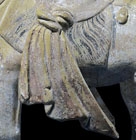J.J. Lally & Co., Oriental Art / New York City, New York
MenuPast Exhibition
Early Chinese Ceramics: An American Private Collection
March 28 - April 16, 2005
6.
A GLAZED AND PAINTED POTTERY FIGURE OF A PRANCING HORSE
Tang Dynasty, circa 7th/8th Century
well modelled in a vigorous posture with right foreleg raised and neck gracefully arched to show the long flowing mane, with head tucked in and turned slightly to one side and mouth wide open, the nostrils flared and the long forelock swept back around the pricked ears, the saddle resting on a tiger-striped saddle blanket and draped with a knotted cloth flaring back on either side, the trappings on the chest and hindquarters decorated with elaborate pendant tassels, the buff pottery covered with a straw-colored glaze attractively degraded to silvery iridescence in many areas, and with extensive original painted decoration still remaining.
Height 16 3⁄8 inches (41.5 cm)
Ex Collection Mrs. P. D. Gresswell, London.
Exhibited at the China Institute and illustrated by Harrist in the catalogue entitled Power and Virtue: The Horse in Chinese Art, New York, 1997, p. 69, no. 8.
Compare the straw-glazed prancing horse of similar model but without the tassels, saddle and saddle blanket, excavated in 1972 from the tomb of Zhang Shigui at Liquan, Shaanxi, province, included in the 1987 exhibition at the Los Angeles County Museum of Art, illustrated in the catalogue, The Quest for Eternity: Chinese Ceramic Sculpture from the People’s Republic of China, Los Angeles, 1987, in color on p. 55, and p. 129, no. 60. This type of horse with one foreleg raised is thought to be modelled after dancing horses which were kept for entertainment at the Tang court during the emperor Xuanzong’s reign (A.D. 712–756). According to the Minghuang zalu (Miscellaneous records of Emperor Minghuang), emperor Xuanzong kept four hundred horses which were specially trained to dance to music. These special breeds of horses from Ferghana and other regions of Central Asia were one of the most sought-after luxuries imported into China on the ‘Silk Road’ during the Sui and early Tang periods and, as emblems of power and wealth, models of these famous horses such as this example, were an essential part of the furnishing of any important tomb.
Compare also the similar prancing horse from the Eumorfopoulos Collection, now in the British Museum, illustrated by Hobson in The Catalogue of the George Eumorfopoulos Collection, Vol. I, pl. 32, No. 240.
唐 彩繪青釉陶鞍馬 高 41.5 厘米
